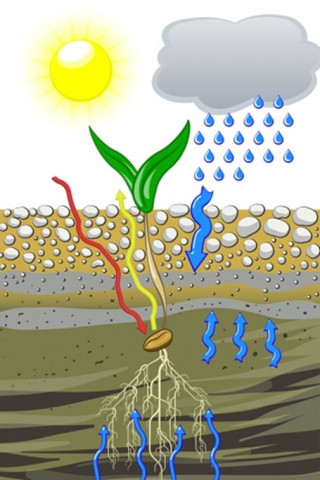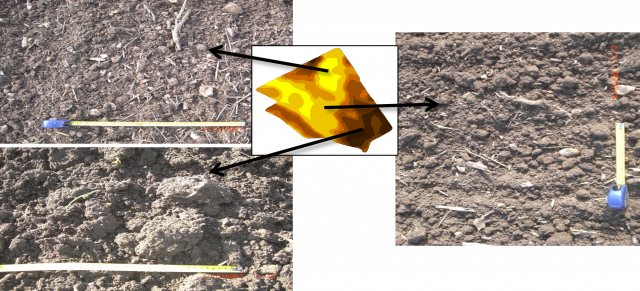Data-based drilling – How can data support continued gains in crop performance?
Much has already been said about the weather that we've experienced in recent months and even with some rain predicted, it is likely to be a challenging drilling season for many. For me, the weather highlights the importance of being able to understand your soils and use that information to make changes to your strategy. Whether it is the creation of the best seedbed in difficult circumstances, or the adjustment of your seed rates to attempt to counteract the conditions, often even small changes can make a big difference.
For an example of the importance of getting your soils right, the AHDB predicts in its barley growth guide that plant establishment can vary between 55 and 75% if drilled in poor conditions. With barley we know the risk is higher too, as it can't compensate as well as wheat for low plant populations because it is limited to either one or three florets on each spikelet, depending on variety.
This poses the question: How can you get a more detailed insight into your soil that has practical value for crop establishment? Well, before we look at that it's worth a very quick recap of what an ideal seedbed looks like.
The ideal seedbed
Creating the right seedbed is always a topic of great discussion, particularly what makes the best seedbed and what equipment you may (or may not) need to achieve it. Put simply, a seedbed must provide the seed with four fundamental things:
- Water
- Air
- Warmth
- A disease-free environment.
The picture below demonstrates how the perfect seedbed provides all four of these key features. It has a top layer of coarser aggregates, which includes organic material such as straw/plant residue and this protects against crust formation. This is followed by a layer of finer aggregates that prevent soil moisture from evaporating and create good contact between seed and soil. Additionally, this layer ensures that the seed will have access to water from the surrounding soil.
Obviously, your soil type is going to influence your seedbed, how close to ideal you can get and how you compensate for that with seed rates. An electroconductivity soil scan is a great way to identify different soil types that will have an impact on crop establishment, which you can then address with variable rate seed plans to ensure you create an even crop canopy.
How does an electroconductivity scan relate to seedbed quality?
The size of the clods in your soil is related to its texture. For example, soils with high clay content can produce a more cloddy, poorer quality seedbed. This makes soil-to-seed contact more difficult and can create a physical barrier to emerging plants. Conversely, if you have a looser soil with finer particles, these can wash together to form a crust which can similarly reduce seedling emergence and prevent air entering the soil.
In a trial, the SOYL team measured clod size in comparison to electroconductivity values and we saw a strong correlation between the two. Soils with higher electroconductivity values typically saw larger soil clods in the seedbed. The results demonstrated that an electroconductivity scan can provide a good indication of seedbed quality, and therefore provides a perfect basis for your choice of seed rate. You can see from the below image how the darker areas on the electroconductivity map in the centre correlate to heavier soils with larger clod sizes.
Converting data to seed in the ground
Now that we've briefly discussed the ideal seedbed and how an electroconductivity scan can help you identify variation across your fields, the next step is to convert that data into an actionable plan to reduce uneven plant populations.
With our variable rate seed service, we can use the results of the soil conductivity scan to predict the quantity of seed we would expect to establish in each of the different soil regions within your field. Further clarification and support is also available via our soil scientists, who are able to visit your farm and classify its soil types based on the results of the electroconductivity readings.
Once you have this information, you can create your variable rate seed plan in MySOYL where you'll have complete control over your seed rates. To see how easy it is to create plans, test scenarios and make changes, you can watch our YouTube tutorial.
What's the benefit of drilling variably?
As I've mentioned, variable drilling helps with creating more even crop canopies. In the graph below, you can see that in one of our trials across four fields, variable rate seed reduced plant count variation by nearly two thirds.
That reduced variation translated at harvest to an average yield increase of 4.67%, which at current commodity process would be a very healthy return on investment.
Adding your own insights
However you choose to drill and establish your crops, I always recommend you record your own observations during the growing season. If you notice areas where the crop was potentially slow to establish or came through too thin or thick, you can fine-tune your approach next year. With tools like our MySOYL app you can log regular observations, note points of interest and upload photos straight from the field. All of that information will come in very handy when it comes to considering your seed rate strategy for future seasons.
I've no doubt everyone will, as always, pay great attention to achieve the best seedbed conditions possible, no matter Mother Nature's plans. The fact is, though, that underlying soil variation will still have an impact, therefore it's important you understand and make adjustments for that variation. This idea is similar to the athletic theory/analogy of 'marginal gains'. When it comes to crop performance, it means that everything we can do each year to make even small improvements to establishment will pay off in the long run.
If you have any questions regarding our variable rate seed service, please get in touch with your local SOYL contact. Alternatively, you can contact the team.
As a subscriber, you’ll receive email alerts each time a new blog is published so you can always stay updated with the latest advice and insights from our experts








Comments